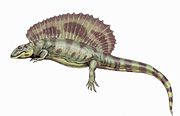
Ianthasaurus
Encyclopedia

Edaphosauridae
Edaphosauridae is a family of mostly large advanced, Late Pennsylvanian to early Permian pelycosaurs.They were the earliest known herbivorous amniotes, and along with the Diadectidae the earliest known herbivorous tetrapods...
from the Late Pennsylvanian
Pennsylvanian
The Pennsylvanian is, in the ICS geologic timescale, the younger of two subperiods of the Carboniferous Period. It lasted from roughly . As with most other geochronologic units, the rock beds that define the Pennsylvanian are well identified, but the exact date of the start and end are uncertain...
. Ianthasaurus lacks many of the spectacular specializations seen in Edaphosaurus
Edaphosaurus
Edaphosaurus is a genus of prehistoric synapsid which lived around 303 to 265 million years ago, during the late Carboniferous to early Permian periods. The name Edaphosaurus means "ground lizard" and is derived from the Greek edaphos/εδαφος and σαυρος/sauros...
. For example, the marginal dentition of Ianthasaurus is similar to that of insectivorous reptile
Reptile
Reptiles are members of a class of air-breathing, ectothermic vertebrates which are characterized by laying shelled eggs , and having skin covered in scales and/or scutes. They are tetrapods, either having four limbs or being descended from four-limbed ancestors...
s, with slender conical teeth which are slightly recurved at the tips, and there is a slight development of a caniniform region. The palatal and mandibular dentition is unspecialized, and there are no batteries of teeth for crushing of plant
Plant
Plants are living organisms belonging to the kingdom Plantae. Precise definitions of the kingdom vary, but as the term is used here, plants include familiar organisms such as trees, flowers, herbs, bushes, grasses, vines, ferns, mosses, and green algae. The group is also called green plants or...
materials. Also unlike Edaphosaurus
Edaphosaurus
Edaphosaurus is a genus of prehistoric synapsid which lived around 303 to 265 million years ago, during the late Carboniferous to early Permian periods. The name Edaphosaurus means "ground lizard" and is derived from the Greek edaphos/εδαφος and σαυρος/sauros...
, Ianthasaurus was lightly built and was probably quite agile. The skull was similar to that to Haptodus
Haptodus
Haptodus was a small sphenacodont, a clade that includes therapsids and hence, mammals. It was at least in length. It lived from Latest Carboniferous to Early Permian, in the equatorial Pangea. It was a medium-sized predator, feeding on insects and small vertebrates. It is one of the basalmost...
, a sphenacodontid
Sphenacodontia
Sphenacodontia is the name given to the clade that includes the Sphenacodontidae and all their descendants . They first appear during the Late Pennsylvanian epoch. The defining characteristics include a thickening of the maxilla visible on its internal surface, above the large front teeth; and...
, though they were distantly related.
Discovery
It was named by Robert R. ReiszRobert R. Reisz
Robert Rafael Reisz is a Canadian paleontologist and specialist in the study of early amniote and tetrapod evolution.Robert Reisz was born August 27, 1947, in Oradea, Romania. He received his B.Sc. , M.Sc. and Ph.D. from McGill University as Robert L. Carroll’s first doctoral graduate...
and David Berman in 1986. It was discovered by them in the Upper Pennsylvanian Rock Lake Shale near Garnett, Kansas
Garnett, Kansas
Garnett is a city in and the county seat of Anderson County, Kansas, United States. As of the 2010 census, the city population was 3,415.-Geography:Garnett is located at...
.

